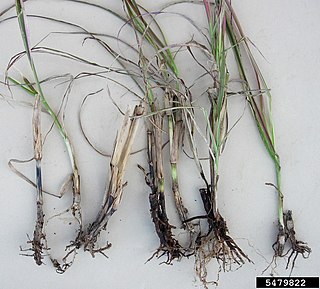
A leaf spot is a limited, discoloured, diseased area of a leaf that is caused by fungal, bacterial or viral plant diseases, or by injuries from nematodes, insects, environmental factors, toxicity or herbicides. These discoloured spots or lesions often have a centre of necrosis. Symptoms can overlap across causal agents, however differing signs and symptoms of certain pathogens can lead to the diagnosis of the type of leaf spot disease. Prolonged wet and humid conditions promote leaf spot disease and most pathogens are spread by wind, splashing rain or irrigation that carry the disease to other leaves.

The Onygenales are an order of fungi in the class Eurotiomycetes and division Ascomycota. The order's last common ancestor is estimated to have lived 150 million years ago.
Phytophthora citricola is a plant pathogen. It was first described by Kaneyoshi (Kenkichi) Sawada in 1927 when it was isolated from orange trees in present-day Taiwan. It has since been found causing disease on a wide variety of plants.

Gaeumannomyces graminis var. graminis is a plant pathogen. This fungal pathogen produces extensive damage on the sheath of rice, causing black spots which protrude from the infected. This pathogen also generates a discoloration in the foliage of a plant which tends to show a straw orange colouration.

Stigmina carpophila is a fungal plant pathogen causing shot hole disease in stone fruits.
Diplodia laelio-cattleyae is a fungal plant pathogen.
Phyllosticta capitalensis is a cosmopolitan fungal plant pathogen that grows on many hosts either as an endophyte or as a saprobe on dead tissue, including species of Citrus and Musa (bananas). There are some reports of it infecting orchids, such as cattleyas or Cymbidium.
Phyllosticta palmetto is a fungal plant pathogen infecting coconuts.
Uredo behnickiana is a fungal plant pathogen. It is known as a pathogen of Cattleya orchids.
Elsinoe rosarum, Anthracnose, is a fungal plant pathogen. It is a condition found on roses, causing leaves to have irregular dark margins and spots. The disease usually appears during wet weather.
Sphenospora kevorkianii is a plant pathogen infecting cattleyas.
Stigmina palmivora is a plant pathogen infecting coconut palms.
Botryodiplodia oncidii is an ascomycete fungus that is a plant pathogen. It causes dieback on Cattleya.
Phoma oncidii-sphacelati is a fungal plant pathogen infecting cattleyas.
Phoma tracheiphila is a fungal plant pathogen. It causes a disease known as Mal secco on citrus trees. It occurs in dry, cool climates such as the Mediterranean, Black Sea and Asia Minor. It forms pycniospores that are carried short distances by rain, or by wind to new leaves, where germinated hyphae invade stomata or more likely fresh wounds.
Coriolopsis floccosa is a fungal plant pathogen.
Pathogenic fungi are fungi that cause disease in humans or other organisms. Although fungi are eukaryotic, many pathogenic fungi are microorganisms. Approximately 300 fungi are known to be pathogenic to humans; their study is called "medical mycology". Fungal infections are estimated to kill more people than either tuberculosis or malaria—about two million people per year.

A fungus is any member of the group of eukaryotic organisms that includes microorganisms such as yeasts and molds, as well as the more familiar mushrooms. These organisms are classified as one of the traditional eukaryotic kingdoms, along with Animalia, Plantae and either Protista or Protozoa and Chromista.

Cattleya jongheana, commonly known as the Jonghe's cattleya, is a species of orchid endemic to Brazil.
In biology, a pathogen, in the oldest and broadest sense, is any organism or agent that can produce disease. A pathogen may also be referred to as an infectious agent, or simply a germ.





